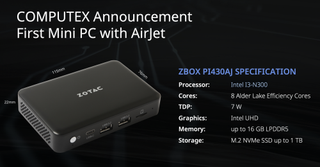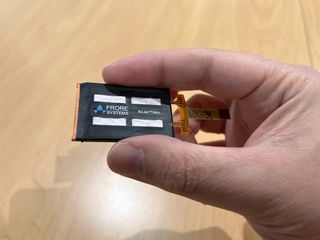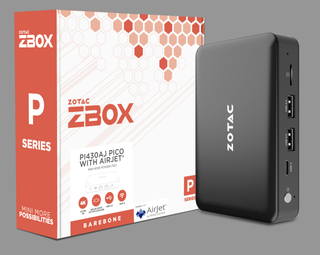Fanless, AirJet Cooling Tech Debuts in Zotac ZBox Mini PC
Fanless cooling

Zotac today announced the Computex debut for its next-generation Mini-PC products marketed in the ZBox family. Powered by Intel's Alder Lake-N, the ZBox PI430AJ Mini-PC (hat tip to FanlessTech) is about what you'd expect from a computing box in this form-factor: it's a small unit with a 7 W Intel i3-N300 (packing 8 Alder-Lake efficiency cores), integrated UHD graphics, up to 16 GB of LPDDR5 memory, and a single NVMe SSD.
But its inclusion of Frore System's AirJet technology is where it separates itself from all others; this is a Mini-PC that promises the performance of an active-cooled Mini-PC while dispensing with large and noisy cooling fans.

Zotac's Computex 2023 booth will showcase a live demonstration of the world's smallest Mini PC equipped with the revolutionary AirJet solid-state active-cooling solution. This groundbreaking mini-PC will be the first product of its kind in the world to feature the revolutionary technology by Frore System.
ZOTAC
Frore System's AirJet aims to reduce the cooling footprint requirements. Fans are simple, reliable, and effective at cooling electronics; decades of incremental improvements on that tech have shown us that the low-hanging fruit for cooling improvement through design have been mostly exhausted (Noctua is one of the few companies considered to be continuously pushing the envelope on its fan designs, and even then, it's a slow, iterative process). But Frore System's AirJet is a new philosophy for system and chip cooling - one co-developed with Intel, for whom cooling space efficiency is paramount due to its High Performance Computing (HPC) products.

AirJet works by pushing ultrasonic waves of air through the fin-like structures across each AirJet "chip", guiding the cool airflow through the AirJet's surface area and moving it away from the silicon components themselves. According to Frore Systems, this approach brings numerous benefits compared to basic fan cooling: AirJet is capable of dissipating the same amount of heat as fan-based coolers, while maintaining low power consumption (it's still active cooling, as it needs to generate the ultrasonic waves, but it's more power efficient than fans) as well as silent operation.
It remains to be seen exactly how efficient Frore System's AirJet can be. Its application on Mini-PCs makes sense: they're products where space is at a premium, even more so than typical desktop systems. This'll be the first consumer-available application of the tech; if it's all that Frore Systems wants it to be, then we may be well on our way towards smaller, more efficient systems that can dedicate most of their volume area to processing chips, instead of the inefficient volume occupied by system fans.

Stay on the Cutting Edge
Join the experts who read Tom's Hardware for the inside track on enthusiast PC tech news — and have for over 25 years. We'll send breaking news and in-depth reviews of CPUs, GPUs, AI, maker hardware and more straight to your inbox.

Francisco Pires is a freelance news writer for Tom's Hardware with a soft side for quantum computing.
-
smrose Reply
I looked for but did not find information on what frequency those operate at. Cats can hear up to about 65KHz and some species of bats up to 200KHz, but let's guess that you are more likely to have a cat (or a dog - 45KHz) sharing space with a SFF computer than a bat.Friesiansam said:Is this going to drive cats and bats mad? -
tennis2 27.5mmx41.5mmx2.8mm = 0.21CFM = 21dBA = 5.25W heat removalReply
^for reference, this is roughly the same airSPEED as a 120mm fan at 60CFM, but obviously the opening is much smaller, hence CFM is very small.
31.5mmx71.5mmx2.8mm = 0.42CFM = 24dBA = 10.75W heat removal
817023989 -
thestryker This is the first new cooling tech I can remember for the longest time that has actually made it into a product. I hope this means they've got manufacturing down as it seems like it'll be spectacular for any small/low power devices. Never having to worry about dust inside is another great benefit.Reply -
punkncat ReplyAirJet works by pushing ultrasonic waves of air through the fin-like structures across each AirJet "chip"
What does this mean, exactly?
This sounds suspiciously like some vague tech jargon designed to make us believe that a groundbreaking development has been made in cooling 7W CPU....
Um?!? -
thestryker Reply
It means quite literally what it says... It's a solid state cooler which moves air with vibrating membranes which propel the air into the heat spreader at very high speed to pull the heat away. Their initial design is for low power and the highest power I've seen them dissipating is around 28W.punkncat said:What does this mean, exactly?
This sounds suspiciously like some vague tech jargon designed to make us believe that a groundbreaking development has been made in cooling 7W CPU....
Um?!?
PC World had a lab tour: WibczqINifAView: https://www.youtube.com/watch?v=WibczqINifA
Most Popular



